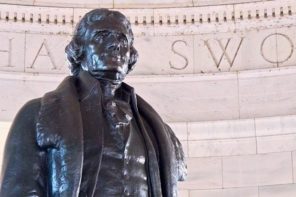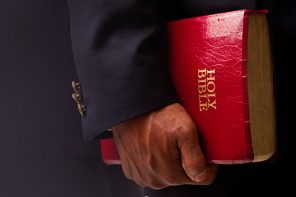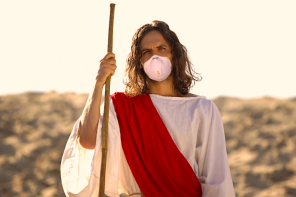To listen to the Christian Right, which has been busy seeking religious exemptions from laws governing reproductive rights and LGBTQ rights, one might think that armies of secularists are swarming like locusts over the land, seeking to snuff out the light of religious freedom and ultimately, of faith itself. Others starkly cast the Christian Right’s campaign as one pitting the religious freedom of some against the civil rights of others, thus effectively ceding the very idea of religious freedom to people whose commitment to the principle may be shaky at best.
Such complexities notwithstanding, most would agree that religious freedom is a good thing even if we can’t agree on exactly what it means. Informed people on all sides also tend to agree that the taproot of religious freedom in the United States is the Virginia Statute for Religious Freedom, originally drafted by Thomas Jefferson in 1777 and shepherded through the Virginia legislature by James Madison in 1786. The following year, Madison served as the principal (but certainly not the only) author of the Constitution, and in 1789, as the principal author of the First Amendment.
In 1992 Congress designated January 16th as Religious Freedom Day to celebrate enactment of the Virginia Statute, stipulating only that it be commemorated by a presidential proclamation.
Religious Freedom Day hasn’t exactly caught on, and there’s no official web site (although an evangelical education outfit managed to purchase the web address for Religious Freedom Day and make it look rather official). Since 2015, the Coalition for Liberty and Justice, an alliance of more than 60 civil liberties, human rights, and religious and secular groups (originally formed in response to the 2014 Supreme Court case, Burwell v. Hobby Lobby) has taken-up Religious Freedom Day as an opportunity to answer Christian Right claims about the meaning of religious freedom.*
Historian John Ragosta, author of Religious Freedom: Jefferson’s Legacy, America’s Creed (University of Virginia Press, 2013), has been writing about the origins of the U.S. approach to religious freedom, particularly the Virginia Statute, the circumstances that gave rise to it and what it means for understanding religion, law and politics in our time.
In the run up to Religious Freedom Day 2018, Ragosta agreed to talk with RD about the roots and the state of religious freedom in the U.S.
———————-
What exactly is the Virginia Statute for Religious Freedom and how did it come to be?
The Virginia Statute is probably the most robust and certainly the most poetic statement of religious freedom in our history. Not only has the Supreme Court relied upon it to for 140 years to define religious freedom [since Reynolds vs. United States, 1879], but it played a critical role in development of the First Amendment and in the way the states defined religious freedom. It was far better known in the nineteenth century when historians, students, newspaper editors and politicians regularly turned to the Statute to understand religious liberty.
Its history is equally important: After the American Revolution there was an effort to impose taxes to support all Christian religions; this was seen as an improvement over colonial laws which had favored specific Christian sects, e.g. Anglican or Congregational. If that effort had succeeded, we could say that America was somehow officially or legally a “Christian Nation.” Fortunately, James Madison and a broad coalition of evangelicals rose up to oppose state interference with religion, even support for religion, and instead managed to have Jefferson’s Statute enacted.
Thomas Jefferson wanted to highlight just three things on the monument that marks his grave–and “not a word more.” Although his remarkable life included being President, Ambassador to France, and Secretary of State, he wanted to be remembered as author of the Declaration of Independence, “Father of the University of Virginia,” and author of the Virginia Statute for Religious Freedom. Why, among his many accomplishments did he so want to be remembered for this 18th century law that most Americans have never heard of?
Jefferson saw these three things as the great accomplishments of his life: political freedom, religious freedom, and educational freedom and opportunity. Of the three, he thought religious freedom was the foundation because without freedom to think and believe, you could not have the other two. A republic could not work if government and church officials (what Jefferson referred to as an alliance of “kings, nobles, and priests”) were trying to control what we think or prescribe what was the “best” religion or which people were the “best” citizens based upon their religious beliefs. If people were to make informed political choices themselves, they had to be free to think for themselves, especially about religion. For Jefferson and his supporters, religious freedom for all was central to our democracy.
What’s most striking to me about the Virginia Statute is the part that reads: “…all men shall be free to profess, and by argument to maintain, their opinions in matters of religion, and that the same shall in no wise diminish, enlarge, or affect their civil capacities.”
Jefferson emphasized that the bill was meant to protect everyone, including as he later wrote, “the Jew and the Gentile, the Christian and Mahometan, the Hindoo, and Infidel of every denomination.” This idea–that one’s religious identity should be neither an advantage nor a disadvantage under the law–seems to be as relevant today as it was then.
Absolutely. The Statute was intended to create a free market of ideas, including religious ideas. Religion would thrive based not on government decisions but on what people believed and chose to support–the “voluntary principle.” The result was an explosion in religious ideas and denominations, and religious leaders were held responsible to their congregants rather than the government. Some conservative ministers who had initially opposed separating church and state admitted that it was the best thing that ever happened to the church.
People sometimes assume that if you want to keep religion out of government and government out of religion you are against religion; Jefferson suffered the same attack. But he and his evangelical supporters wanted a strict wall of separation between church and state–and yet [they] believed that there would be a vibrant religion on the “other” (non-government) side of the wall.
At the same time, while belief is completely free from government regulation and government cannot directly regulate the free exercise of religion, government can pass “neutral” laws (not targeted at religion) which may happen to be inconsistent with a person’s beliefs.
Jefferson used the obvious example of child sacrifice or a law which prohibited the slaughter of lambs when the military was in short supply of wool uniforms. The best modern example is laws against racial discrimination: While many people insisted that interracial dating or marriage violated their religion, the Supreme Court, in the 1983 case of Bob Jones University v. United States, rightly refused to grant an exemption to anti-discrimination laws based on religion.
This is exactly what is at issue in the claims for exemptions from laws dealing with LGBTQ rights. Government cannot tell a church that it must marry gay people (that would be a direct regulation of religion), but government can say that if you want to run a business (using public streets, public utilities, police and fire protection, etc.), you cannot discriminate against customers based on race, gender, or sexual orientation. Of course, if people don’t like particular laws, they can be changed, but Jefferson was very clear that you can’t use religion or religious freedom to claim an exemption from an otherwise valid law.
How do we simultaneously draw on our religious (and non-religious) beliefs and values in public life while also adhering to Jeffersonian values regarding religious pluralism and separation of church and state?
The key then and now is to recognize that government must be secular, but that doesn’t mean that people or society are. If government seeks to lead a prayer (for example when teachers lead prayer in public schools or if officials call on everyone to stand and pray before a public meeting) that is unacceptable, but private citizens are free to pray, including in public.
There are close cases, but a specific example may help: During a crisis, President Jefferson was asked to make an official proclamation calling on people to pray for the country; he refused, saying that it would violate the Constitution. Even if there was no criminal penalty or fine for not praying, Jefferson said that he believed the proclamation would give the erroneous idea that “good” citizens would join in prayer. This was the “tyranny over the mind of man” that Jefferson fought against.
Yet, government officials are still people and, when acting as private persons, can engage in religious activities; so Jefferson said a prayer (a very non-denominational prayer) at his inaugurations and attended church while president. The problem is any official or formal religion.
Many proponents of Christian nationalism seize on the religious language in the Declaration of Independence to ascribe religious intention to the Constitution and the First Amendment. How do we reconcile the founding principle of government neutrality toward religion with the religiosity of most if not all of those who wrote and ratified the Constitution and the First Amendment?
Certainly most early Americans, including most of the Founders, were Christian–although some, like Jefferson, were not. (Jefferson rejected Jesus’ divinity, the resurrection, original sin, atonement, etc.; he is best described as a Unitarian.) But these same, very religious people decided that mixing church and state would corrupt both; separating them was best for both.
The Declaration of Independence includes very broad and general language about a “creator,” but it is telling that the only reference to God or religion in the Constitution is Article VI which mandates that “no religious test shall ever be required as a qualification to any office or public trust.” This was not a mistake. These religious people decided that it would be better for the country, for both government and religion, to keep them separated.
I think we can all acknowledge that the principle of religious freedom has been both foundational and aspirational. In 2016, you wrote in an op-ed in the Richmond Times Dispatch, that we must return to the ideals of Jefferson’s Statute. As we reflect on the meaning of the 26th annual Religious Freedom Day, what are some things we can we do to sustain and advance these ideals in our time?
One simple but powerful thing is to read the Virginia Statute in schools, in churches, at home, especially on Religious Freedom Day. It should be posted in schools and other public places. It is compelling.
Then we have to live it, including allowing others to have their beliefs. Jefferson once suggested that perhaps the only thing that we should require of anyone to be tolerated in our society is their commitment to tolerate others.
Eighteenth century Presbyterians and Baptists would often note that if government could discriminate in favor of any religion, even all Christian religions, it also had the authority to attack a particular religion or all religions. They realized that complete separation of church and state was the best way to promote true religion.
Our original national motto speaks to the way that our religious, ethnic and racial diversity is a source of greatness: E Pluribus Unum–out of many, one. This is nowhere more true than in religion. Jefferson once explained that the normal rule in politics was reversed when talking about religion; for religion, “divided we stand, united we fall.” Our diversity itself protects us from government trying to control how and what we think. This is the blessing of religious freedom.
*Full disclosure: I represent my employer, Political Research Associates in the Coalition.





